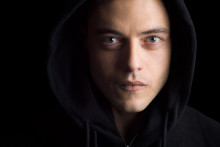In this second edition of Pop Culture, the TV show Mr. Robot (2015 - present) is analysed by Luuk Hendriks, PhD candidate at Design and Analysis of Communication Systems (DACS). For those who have not seen this show yet, beware of spoilers!
The plot
During the day, Elliot Anderson (played by Rami Malek) works for an internet security company, while he leads a double life as a hacker at night. The anarchistic ‘Mr. Robot’ recruits him into the ‘fsociety’ hackers’ collective, whose goal is to destroy the debt records of E Corp. In this fictional universe, E Corp is the world’s largest conglomerate. With their hack, the group wants to achieve the collapse of the global financial markets.
First impression
Hendriks: ‘It has been a while, but I enjoyed watching Mr. Robot. The remarkable thing is that I encountered hardly any errors in the storyline. That is quite unusual. When you turn on the news, hacking is usually misrepresented entirely. When the presenter opens an htop screen on their computer, that might look interesting to a layman, but it has nothing to do with hacking.’
‘It is not just the technical aspects of this show that are believable. Mr. Robot has a dark and dystopian edge with characters who are – as we say nowadays – on the autistic spectrum. Although that is a generalisation, it is appropriate for a subculture that mostly consists of young loners.’
Realism/feasibility
‘The premise of the show, a group of hackers taking on a major corporation, is something that also happens in real life. I fear these kinds of cyberattacks and cyber physical warfare will only become more common. Mr. Robot paints an accurate picture of this world and also shows the possible consequences of a successful hack.’
‘We live in a world in which several major organisations collect a wealth of information about each and every one of us. That is part of the reason why I do not have a Facebook account and am careful about how I use the internet. When you connect your Gmail account to your Android phone and use Google’s search engine, the company will know virtually everything there is to know about your behaviour. This show gets people thinking about whether they want all their personal information to be in the hands of a few major commercial organisations.’
Stray observations
‘Darlene, the main character’s sister, writes the code to take advantage of a leak in a program in just one hour. The show pushes the limits of credibility with that. I am not saying that it is impossible to write a script like that in such a short time, but it is borderline unbelievable.’
‘The hackers spend a lot of time in the dark, alone, sitting behind their computers. Drug abuse is also a part of the show. That is a stereotype, although there are definitely real-life parallels. Hacking is not a nine-to-five activity. Instead, you are unrestricted by time or location. When I keep working on something in the evening, I also regularly find myself sitting in a poorly lit room at two in the morning. The only difference is that my drug is coffee.’
‘The hackers’ collective fsociety meets in an abandoned arcade. That is not very believable. I do not think many hackers have a physical place to meet. What is realistic is that they do not use their own internet connections to initiate a cyberattack.’
‘The main character, Elliot, suffers from delusions and depression. This allows the show to play around with what is real and what exists only in his head. Elliot’s condition also obscures his moral boundaries. That provides an interesting perspective on the morality of hacking. The DACS group I am part of works with large data sets. In theory, we should ask every single person for permission to use their information. We consider ourselves to be the good guys in the world of cybersecurity, but this does show that there is a substantial grey area in what we do.’
This article also appeared in the latest edition of the U-Today Science & Technology Magazine.







